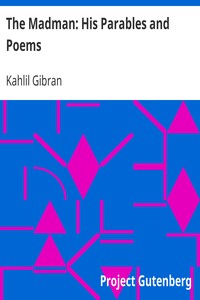| Summary |
"The Madman: His Parables and Poems" by Kahlil Gibran is a poetic collection that delves into profound themes of identity, existence, and the nature of humanity, characteristic of Gibran's literary style in the early 20th century. This work reflects a philosophical exploration of the human condition through parables and poems, imbuing them with spiritual and metaphysical insights. Written during the early modern period, the book brings a unique blend of mystical thought and artistic expression. The content of "The Madman" is structured around the thoughts, musings, and experiences of a narrator who embodies the qualities of a madman, yet offers wisdom in his madness. He reflects on various aspects of life such as love, friendship, existence, and societal norms through engaging parables, like the tale of the scarecrow who finds joy in his loneliness and stories that reveal the darker complexities of the human psyche. Gibran addresses the struggle between individuality and societal expectations, exploring themes of conflict, love, and enlightenment as the madman navigates his own reality, ultimately portraying both the burdens and the liberating aspects of madness. This collection invites readers to contemplate deeper truths about their own lives and the world around them. (This is an automatically generated summary.)
|

